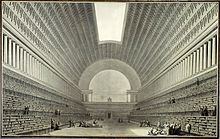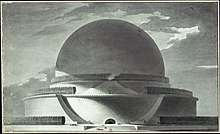Type a search term to find related articles by LIMS subject matter experts gathered from the most trusted and dynamic collaboration tools in the laboratory informatics industry.
Étienne-Louis Boullée | |
|---|---|
| Born | 12 February 1728 Paris, France |
| Died | 4 February 1799 (aged 70) Paris, France |
| Occupation | Architect |
| Practice | Neoclassicism |
| Buildings | Hôtel Alexandre |

Étienne-Louis Boullée (French pronunciation: [etjɛn lwi bule]; 12 February 1728 – 4 February 1799) was a visionary French neoclassical architect whose work greatly influenced contemporary architects.

Born in Paris, he studied under Jacques-François Blondel, Germain Boffrand and Jean-Laurent Le Geay, from whom he learned the mainstream French Classical architecture in the 17th and 18th century and the Neoclassicism that evolved after the mid century. He was elected to the Académie Royale d'Architecture in 1762 and became chief architect to Frederick II of Prussia, a largely honorary title. He designed a number of private houses from 1762 to 1778, though most of these no longer exist; notable survivors into the modern era include the Hôtel de Brunoy (demolished in 1930) and the Hôtel Alexandre, both in Paris. His work for François Racine de Monville has apparently also vanished but his probable influence on Monville's own architectural works as seen at the Désert de Retz speaks for itself. Together with Claude Nicolas Ledoux, he was one of the most influential figures of French neoclassical architecture.
It was as a teacher and theorist at the École Nationale des Ponts et Chaussées between 1778 and 1788 that Boullée made his biggest impact, developing a distinctive abstract geometric style inspired by Classical forms. His work was characterised by the removal of all unnecessary ornamentation, inflating geometric forms to a huge scale and repeating elements such as columns in huge ranges.
For Boullée regularity, symmetry and variety were the golden rules of architecture.

Boullée promoted the idea of making architecture expressive of its purpose, a doctrine that his detractors termed architecture parlante ("talking architecture"), which was an essential element in Beaux-Arts architectural training in the later 19th century. His style was most notably exemplified in his proposal for a cenotaph (a funerary monument celebrating a figure interred elsewhere) for the English scientist Isaac Newton,[1] who 50 years after his death became a symbol of Enlightenment ideas.[1]
The building itself was a 150 m (500 ft) tall sphere, taller than the Great Pyramids of Giza,[1] encompassed by two large barriers circled by hundreds of cypress trees. The massive, spherical shape of the building was inspired by Boullée's own study called "theory of bodies" where he claims that the most beautiful and perfect natural body is the sphere, which is the most prominent element of the Newton Memorial.[2] Though the structure was never built,[1] Boullée had many ink and wash drawings engraved and circulated widely within professional circles in 1784.[1]
The small sarcophagus for Newton would have been placed at the lower pole of the sphere. The design of the memorial was intended to create the effect of day and night. The night effect would have occurred when the sarcophagus is illuminated by the sunlight coming through the holes in the vaulting, giving the illusion of stars in the night sky. The day effect would have been provided via an armillary sphere hanging in the center that gives off a mysterious glow. Thus, the use of light in the building's design would have caused the building's interior to change its appearance.[3]
The boiseries, still often dated in the mid-1760s, were discussed in the issue of L'Avant-coureur for 21 January 1761, and so must have been carried out about 1758–59.[4] The Hôtel in the Marais district remodelled for Claude-Charles-Dominique Tourolle survives (the rue d'Orléans is now the rue Charlot) but the salon's boiseries and chimneypieces were removed in the mid-nineteenth century to a house in the rue du Faubourg Saint-Honoré now in the possession of the Cercle Interallié. Round-arched mirrors over the chimneypieces and centering the long wall in a shallow recess are disposed in a system of stop-fluted Ionic pilasters. White marble draped caryatid therm figures support the chimneypiece's tablette. There is a full architrave under a dentilled cornice. The white-and-gold ensemble would still have been fully in style in 1790.

The Hôtel Alexandre or Hôtel Soult, rue de la Ville l'Évêque, Paris (1763–1766), is the sole survivor of Boullée's residential work in Paris. It was built for the financier André-Claude-Nicolas Alexandre.[5] In its cour d'honneur four Ionic columns embedded against a recess in the wall plane create an entry (now glazed). Flanking doors in the corners of the courtyard have isolated architraves embedded in the wall above their plain openings, while above oval bull's-eye windows are draped with the swags of husks that became a common feature of the neoclassical manner. The garden front has a colossal order of pilasters raised on the high basement occupied by the full height of the ground floor.
Boullée's ideas had a major influence on his contemporaries, not least because of his role in teaching other important architects such as Jean Chalgrin, Alexandre-Théodore Brongniart, and Jean-Nicolas-Louis Durand. Some of his work only saw the light of day in the 20th century; his book Architecture, essai sur l'art ("Essay on the Art of Architecture), arguing for an emotionally committed Neoclassicism, was only published in 1953. The volume contained his work from 1778 to 1788, which mostly comprised designs for public buildings on a wholly impractical grand scale.
Boullée's fondness for grandiose designs has caused him to be characterised as both a megalomaniac and a visionary. His focus on polarity (offsetting opposite design elements) and the use of light and shadow was highly innovative, and continues to influence architects to this day. He was "rediscovered" in the 20th century and has influenced recent architects such as Aldo Rossi.
Peter Greenaway's film The Belly of an Architect (1987) concerns a fictitious architect who is staging an exhibition devoted to Boullée's work. The film contains many visual references to Boullée.